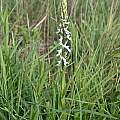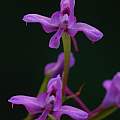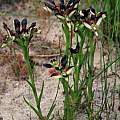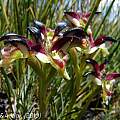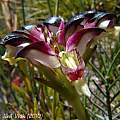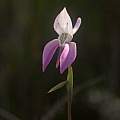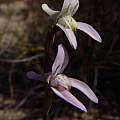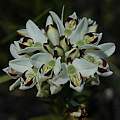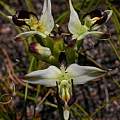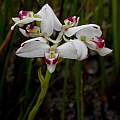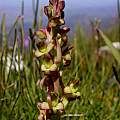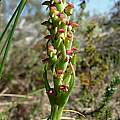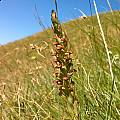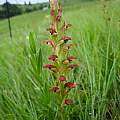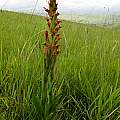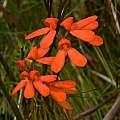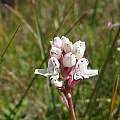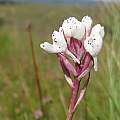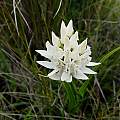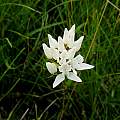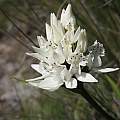Disa is a genus in the family Orchidaceae and is mostly found in southern and eastern Africa. Species are deciduous or evergreen terrestrial plants with both tuberous and stoloniferous root systems. They are found from sea level to about 7000 feet. Species a-ce are found on this page.
Disa species ch-f - Disa species g-n - Disa species o-r - Disa species s-z - Disa index
Disa aconitoides Sond. is found in grassland and forest margins from the Southern Cape to Malawi. It grows from 25 to 50 cm and has flowers that are white to pale mauve with darker spots and with a deeply hooded upper petal. It blooms late spring-early summer. Photos by Cameron McMaster taken in the Eastern Cape.
Disa arida Vlok is a rare species restricted to rocky outcrops in arid fynbos in the Little Karoo. It grows to 50 cm and flowers in autumn when the leaves are dry. Photos and information from the book Plants of the Klein Karoo courtesy of Jan and Anne Lise Schutte-Vlok.
Disa atricapilla (Harv. ex Lindl.) Bolus is a winter rainfall species from 5-30 cm that grows in marshy places on flats and slopes from the Western Cape to the Karoo Mountain area (Cederberg Mountains to the Cape Peninsula to the Swartberg Mountains). Flowers are multicolored: white, red and black and are arranged in a horizontal circle and mimic female wasps and thus attract male wasps. This species blooms late spring to summer. The first photo was taken by Rod Saunders. The next two from the book Plants of the Klein Karoo courtesy of Jan and Anne Lise Schutte-Vlok who write this species flowers only the first year after a fire.
Disa bifida (Thunb.) Sw. grows on sandstone slopes and deep sand plains in the southwestern Cape. It has a small basal rosette of leaves and a stem up to 10" (25 cm) tall, with 1-4 flowers. It blooms in late winter to spring. The first photo was taken at Phillipskop Mountain Reserve by Christopher Whitehouse. The second photo from the book Plants of the Klein Karoo is courtesy of Jan and Anne Lise Schutte-Vlok.
Disa bivalvata (L.f.) T.Durand & Schinz is a winter rainfall species that grows from 10-45 cm. It is widespread from 0 to 2000 m from the western Cape to the southeastern Cape where it is found in marshes and damp mountain slopes. It has white and dark red flowers and blooms late spring to summer. Flowers are arranged in a horizontal circle that mimic female wasps and thus attracts male wasps. This species is similar to Disa atricapilla and hybridizes with it where both are present, but the two large spreading petals are white in this species. The first photo is by Rod Saunders. The next photos from the book Plants of the Klein Karoo is courtesy of Jan and Anne Lise Schutte-Vlok who write that this species only flowers the first year after a fire.
Disa bolusiana Schltr. occurs from the Cape Peninsula to George. It grows on rocky outcrops in fynbos and is found on coastal and inland mountains. Growing to 30 cm and flowering from late spring to early summer, flowers are green tinged purple-red. The photo below from the book Plants of the Klein Karoo courtesy of Jan and Anne Lise Schutte-Vlok.
Disa bracteata Sw. is found in moist, open, sandy places on flats and in mountains and in disturbed grassland and roadsides in the Western and Eastern Cape, South Africa. Growing from 15 to 50 cm, it has many small greenish tinged maroon flowers in a dense spike and blooms September to November. Photos were taken by Cameron McMaster near Napier in the Overberg.
Disa brevicornis (Lindl.) Bolus is found in grassland from Knysna in the southern Cape to Malawi. Flowers in a dense spike are brown and green. Height range: 15-50 cm. Photos by Cameron McMaster taken at Mt. Kubusie in the Amatola Mountains and Satansnek Pass, Eastern Cape, South Africa.
Disa cardinalis H.P.Linder is an evergreen species that grows from 30 to 60 cm tall in the southern Cape and has attractive bright red flowers and blooms October to December. Photo by Ragnhild Crawford.
Disa cephalotes Rchb.f. is a summer rainfall species with two subspecies.
Disa cephalotes subsp. cephalotes grows from 15 to 40 cm tall and is found in dry or damp grassland in the Eastern Cape, the Free State and KwaZulu-Natal. It has hard narrow leaves and a dense compact roundish inflorescence of white flowers with purplish red spots on the hood. It blooms in summer. Photos 1-2 were taken at Mafika-Lisiu Pass and 3-5 at Sentinel Peak in the Drakensberg by Cameron McMaster.
Disa cephalotes subsp. frigida (Schltr.) H.P.Linder is found in small or large colonies on damp or dry grass slopes in the Drakensberg. It grows from 15 to 20 cm and has soft lower leaves clustered at the base and a dense compact inflorescence of deep pink flowers that have purple speckles on the tips of the sepals. It flowers in summer.
Disa species ch-f - Disa species g-n - Disa species o-r - Disa species s-z - Disa index

